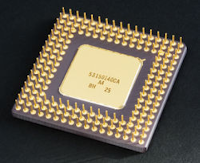The central processing unit, or CPU, is the part of the computer that executes software
programs, including the operating system. Nearly all PCs contain a type of CPU known as a
microprocessor. The microprocessor often plugs into the motherboard using one of many different
types of sockets. IBM PC compatible computers use an x86-compatible processor, usually made by
Intel, AMD, VIA Technologies or Transmeta. Apple Macintosh processors were based on the
Power PC (a RISC architecture) but as of 2005, Apple has used x86 compatible processors from
Intel.
Intel 80486DX2 microprocessor in a ceramic PGA package
A central processing unit (CPU), or sometimes simply processor, is the component in a
digital computer that interprets instructions and processes data contained in computer programs.
CPUs provide the fundamental digital computer trait of programmability, and are one of the
necessary components found in computers of any era, along with primary storage and input/output
facilities. A CPU that is manufactured using integrated circuits is known as a microprocessor. Since
the mid-1970s, single-chip microprocessors have almost totally replaced all other types of CPUs,
and today the term "CPU" is usually applied to some type of microprocessor.
The phrase "central processing unit" is, in general terms, a description of a certain class of
logic machines that can execute complex computer programs. This broad definition can easily be
applied to many early computers that existed long before the term "CPU" ever came into
widespread usage. However, the term itself and its initialism have been in use in the computer
industry at least since the early 1960s (Weik 1961). The form, design and implementation of CPUs
have changed dramatically since the earliest examples, but their fundamental operation has
remained much the same.
Early CPUs were custom-designed as a part of a larger, usually one-of-a-kind, computer.
However, this costly method of designing custom CPUs for a particular application has largely
given way to the development of inexpensive and standardized classes of processors that are suited
for one or many purposes. This standardization trend generally began in the era of discrete transistor
mainframes and minicomputers and has rapidly accelerated with the popularization of the integrated
circuit (IC). The IC has allowed increasingly complex CPUs to be designed and manufactured in
very small spaces (on the order of millimeters). Both the miniaturization and standardization of
CPUs have increased the presence of these digital devices in modern life far beyond the limited
application of dedicated computing machines. Modern microprocessors appear in everything from
automobiles to cell phones to children's toys.





No comments:
Post a Comment